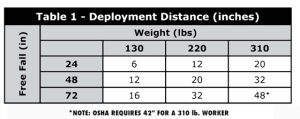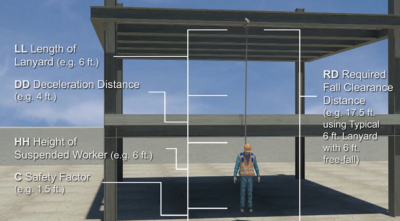Correctly Calculating Your Required Fall Clearance Distance: Rigid Anchor Points
One of the most important factors when selecting the proper fall arrest system is fall clearance distance, or the distance required to prevent personnel from coming into contact with equipment or surfaces below the work surface. If the proper calculations aren’t taken into consideration, or if the wrong type of system is specified, a worker can come into contact with the ground or surfaces below the work area before the system has had time to properly deploy and arrest the fall. In this post, we will discuss required fall clearance distances with rigid anchor points (look for a future post that discusses required fall clearance distances for horizontal lifelines).
The required fall clearance distance from a rigid anchor point is calculated using the following formula:
Required Distance (RD) = Lanyard Length (LL) + Deceleration Distance (DD) + Height of Suspended Worker (HH) + Safety Factor (C)
Free fall distance, or the distance before your fall arrest system begins to slow you down, is the first factor we need to calculate when determining your required fall clearance distance. Properly designed fall arrest systems should prevent workers from coming into contact with obstructions and equipment positioned beneath the work area, with a maximum free fall distance of six feet. This is why calculating your fall clearance distance from your anchor point is so important.
If you are using a six foot lanyard connected to the dorsal D-Ring of your body harness and connect the other end to an anchorage point at the same height, how far will you free fall? Answer—six feet because this is the length of the lanyard connecting the two points together. But what about a connection to an I-beam positioned 4 feet below your dorsal D-Ring? In this instance, you’ll free fall 10 feet …4 feet to the I-Beam plus the six feet of lanyard.
Free fall is the first factor needed to calculate your required fall clearance distance. To determine if we have enough clearance, we must add our free fall distance plus deceleration distance, which is the amount of distance before the shock absorbing lanyard begins to slow your fall. Deceleration distance is based on a variety of factors, including:
- User Weight
- Free fall distance
- Type of lanyard used
To illustrate, let’s assume a scenario where a worker is connected to an overhead anchor point with a standard, six foot lanyard and that he is in a standing position during the fall. When the worker falls, the energy absorber on the lanyard activates, creating a deceleration distance of four feet. At the onset of a fall, the worker harness will shift slightly and the dorsal d ring will slide slightly upwards on the harness straps. This combination is called harness stretch. This factor plus the workers height is typically measured at six feet. The safety factor is defined as the distance between the workers feet and the surface below at the instant the fall is arrested prior to any bounce back. The typical distance is 1.5 feet. So in this illustration, the required fall clearance distance is 17.5 feet with a six foot lanyard plus a 6 foot free fall, as shown below:
As the illustration shows, as long as this worker has 17.5 feet of fall distance clearance, all is well, but what if there is an obstruction 10 feet below the work area? In this case, our worker will need to consider use of a self-retracting lifeline (SRL) to arrest his fall sooner.
Anchor position, lanyard length, deceleration distance, height of the suspended worker, and safety factor are good starting points when attempting to properly calculate fall distance clearance and PPE requirements, but remember there may be additional variables that need to be considered The type of PPE, position of worker, and the nature of the fall (e.g., swing falls) must also be taken into account. Only when ALL of these factors are considered can you safely determine your true fall distance and fall clearance requirements. Remember, safety is a culture…it isn’t purchased. To learn more about our unique, turnkey approach to fall protection, visit us online at www.fallprotect.com or contact us to discuss your fall arrest requirements.
Schedule an assessment with Diversified Fall Protection
Contact Us to request a fall safety review

b-1.jpg?width=1368&height=1340&name=Rail%20(175)b-1.jpg)



